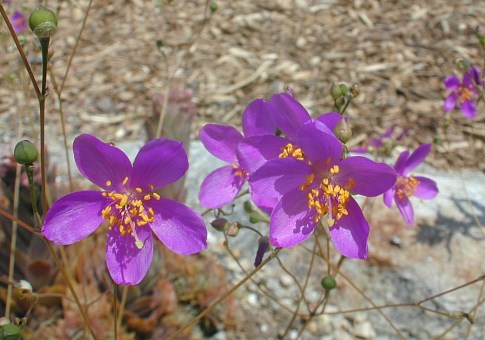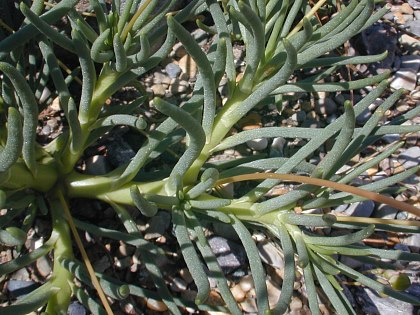Description: This perennial wildflower produces ascending stems 2-6" long that branch occasionally. These stems are surrounded by finger-like leaves that are ascending to widely spreading; the stems are light green, glabrous, and succulent. The leaves are up to 3" long, terete in cross-section, and succulent; they are green to blue-gray and glabrous. Occasionally, the upper stems produce cymes of flowers on long slender stalks (peduncles); these stalks are 4-10" long. Each cyme is open and widely spreading (up to 12" across); its branching structure is dichotomous or trichotomous. Pairs of tiny lanceolate bracts occur along the branches of each cyme. Usually, each cyme has about 5-50 flowers, although poorly developed cymes may have fewer flowers than this. Each flower spans about 1" across, consisting of 5 petals, 2 sepals, 30-45 stamens, and a pistil with a single slender style. The widely spreading petals are deep rose pink and well-rounded, while the sepals are light green to membranous and ovate to oval-orbicular in shape. The petals are much longer than the sepals. The style of each flower is about twice the length of the stamens; there is a knobby stigma at the end of the style.

The blooming
period occurs intermittently during the summer for 1-3 months;
sometimes several flowers bloom at the same time. The flowers open on
sunny days during the early afternoon for about 2 hours; individual
flowers last only a single day and they lack fragrance. Each fertile
flower is replaced by a seed capsule that is up to 1/3" (8 mm.) in
length; it is ovoid-globoid in shape, and divides into 3 parts to
release the tiny seeds inside. Individual seeds are about 1 mm. in
length; they are reniform and flattened in shape with smooth outer
surfaces. The seeds are small enough to be blown about by the wind. The
root system consists of a thickened taproot with fibrous secondary
roots.
Cultivation:
The preference is full sun, dry conditions, and soil that is rocky,
gravelly, or sandy. This species is adaptable to a sunny rock garden
and it is intolerant of competition from tall aggressive plants.
Range & Habitat:
Large-Flowered Rock Pink has been found in only a single county in SW
Illinois, where it is extremely rare (see Distribution
Map). This native species is state-listed as endangered.
Large-Flowered Rock Pink occurs primarily in the southern plains;
Illinois lies at the NE range limit for this species. In Illinois,
habitats are restricted to sunny ledges of sandstone cliffs. In others
states, habitats include rocky glades, hill prairies, and barren upland
savannas. Occasionally, this species is cultivated in gardens because
of the attractive flowers and foliage.

Faunal
Associations:
Very little is known about floral-faunal relationships for this
species. The webmaster observed a medium-sized dark bee collecting
pollen from the flowers while they were being photographed.
Photographic Location:
A flower garden at the Arboretum of the University of Illinois in
Urbana, Illinois.
Comments:
Other common names include Large Flower-of-an-Hour and Fame-Flower. The
flowers are beautiful, but short-lived. Two other species in this genus
that occur in Illinois are Phemeranthus parviflorus
(Small-Flowered Rock Pink) and Phemeranthus rugospermus
(Sand Rock Pink). The flowers of these latter species are smaller in
size (less than ¾") and the styles of their flowers are about the same
length as the stamens. In contrast, Large-Flowered Rock Pink has
flowers about 1" across and the styles of its flowers are about twice
the length of the stamens. Without observing the flowers, it is very
difficult to distinguish these species. Interestingly, each of these
species blooms during a different time of the day: Small-Flowered Rock
Pink blooms during the morning, Sand Rock Pink blooms during the late
afternoon, while Large-Flowered Rock Pink blooms during the early
afternoon. A scientific synonym of Large-Flowered Rock Pink is Talinum calycinum.